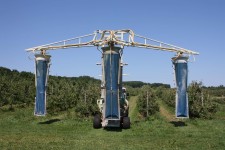Top Five Specialty Crop Chemical Trends

According to USDA, specialty crop production represents about half of U.S. crop production. A $60 billion industry that encompasses seed, nutrients and crop protection, one has to wonder what crop inputs this market will be demanding down the road. FCI sat down with certified crop advisor Francisco Rivera-Guerrero of J.R. Simplot, one of the largest privately held food and agribusiness companies in the country, who identified five trends he is experiencing.
1) Mixing it Up
Rivera-Guerrero cites growers’ mixing of chemicals, especially fungicides, as the biggest trend in the specialty crop industry due to rising resistance issues in crops. “New crop varieties appear to be much more susceptible to powdery mildew, downy mildew and other plant fungi,” he explains, which translates to more spraying and more potential for resistance.
“Crops like table grapes and strawberries, which are very high-value crops, are very intensively farmed, meaning they require weekly sprays to protect them from pests, which can quickly raise the risk of resistance and limit the options growers have to combat disease in general.” Thus chemical companies should expect continued grassroots demand for premixes and chemistries with combined actives to meet this growing need.
2) Squeaky Clean Chemistries
Growers are becoming more socially and environmentally aware and feel the need to be responsible for the applications they make at the farm level and how they impact society as a whole, says Rivera-Guerrero.
One reflection of this in the chemical industry is the fact that many formerly petroleum-based formulations such as emulsifiable concentrates (EC) were used for years to form a suspension of the active ingredient and allow for uniform application with varying dilution rates. He explains that there has been a strong move away from ECs in favor of suspension concentrates and flowables, which he says provide a good way of suspending the material in the tank without causing phytotoxicity in the crop.
3) In with the Old
Chemical companies developing new products make investments of more than $300 million per active ingredient. This, thankfully might not be necessary for every product that hits the market as growers are trending toward older chemistries with slight tweaks.
“There is a market demand for older products with an environmentally friendly twist,” he explains. “EC formulations, for example, are fairly old chemistries that are getting a makeover by simply switching out the petroleum for a water-based suspension. GoalTender and Lorsban Advanced by Dow AgroSciences are perfect examples of this.”
4) International Awareness
Despite the image the average consumer has of growers being small-town, old-school types, Rivera-Guerrero says that greater international awareness is spreading throughout the industry. “Growers are competing at a global level,” he says, “especially when their produce is exported to these foreign markets.”
The average U.S. grower now needs to be aware, he says, that when fresh market tomatoes are ready in Florida, they’re competing directly with Mexico’s tomatoes that are being imported in the States. For the chemical industry, this means much more calculated use of products not only to avoid pest issues, but for timing and weather issues as well.
5) Gene Therapy
Growers are choosing more genetically-oriented materials than ever before. Companies are spending more time trying to figure out which genes are involved in disease in plants. By investigating this further, they are attempting to find out how to manipulate genes to get plants to turn on their own defenses and rely less on chemical fungicides.
The fertilizer sector has been spending significant time and money on this research, he says. “By knowing what genes are ‘turned on’ and which are ‘turned off,’ companies can develop foliar fertilizers packaged with micronutrients that help move the material within the vascular system of the plant. This helps plants develop their own internal adrenaline-like reaction, thereby increasing the plants’ own defense against disease which may attack it. This is what growers are really looking for.”






